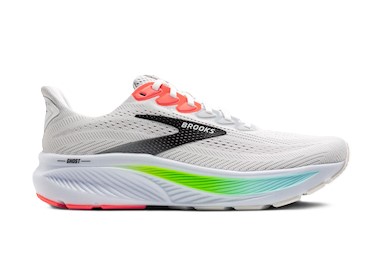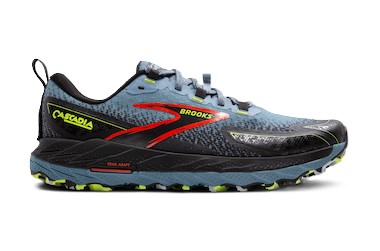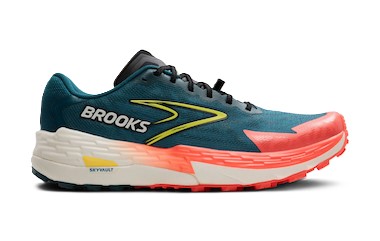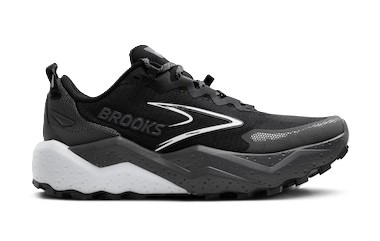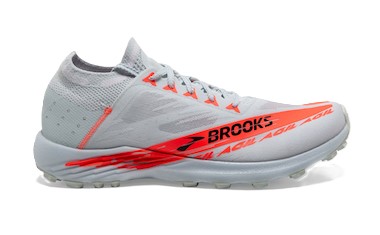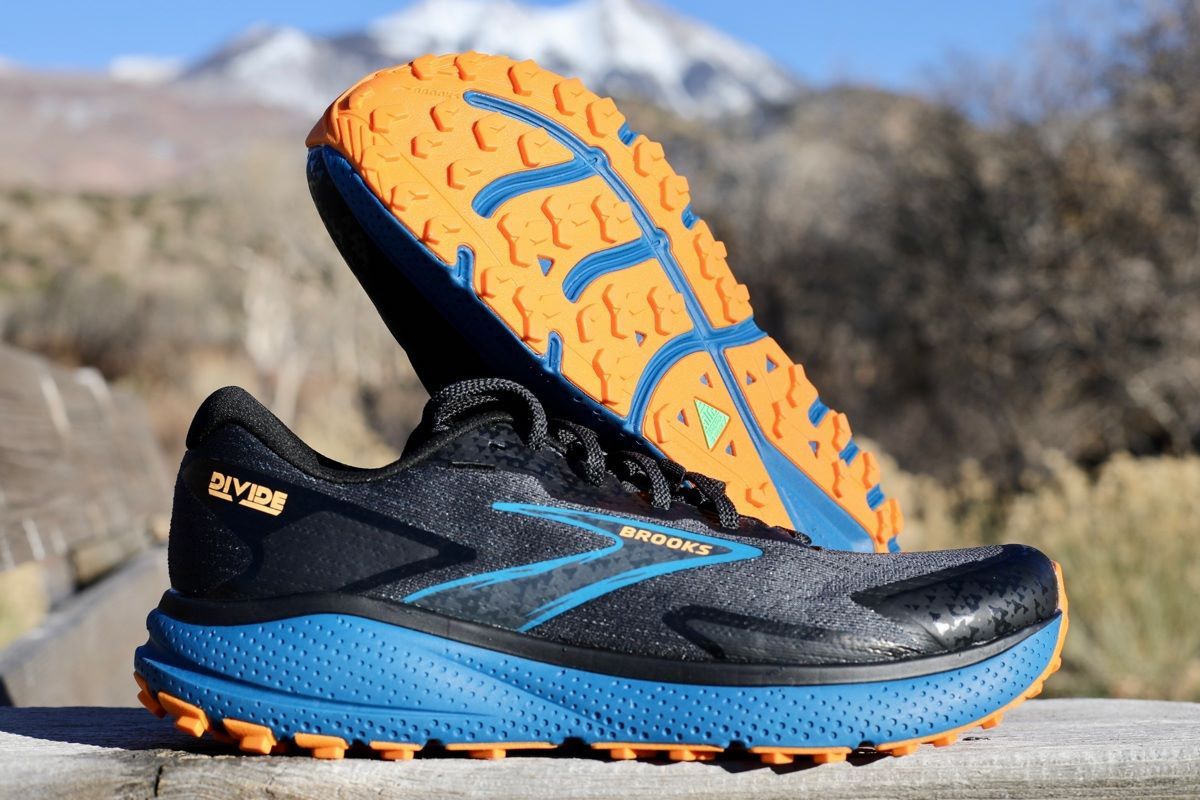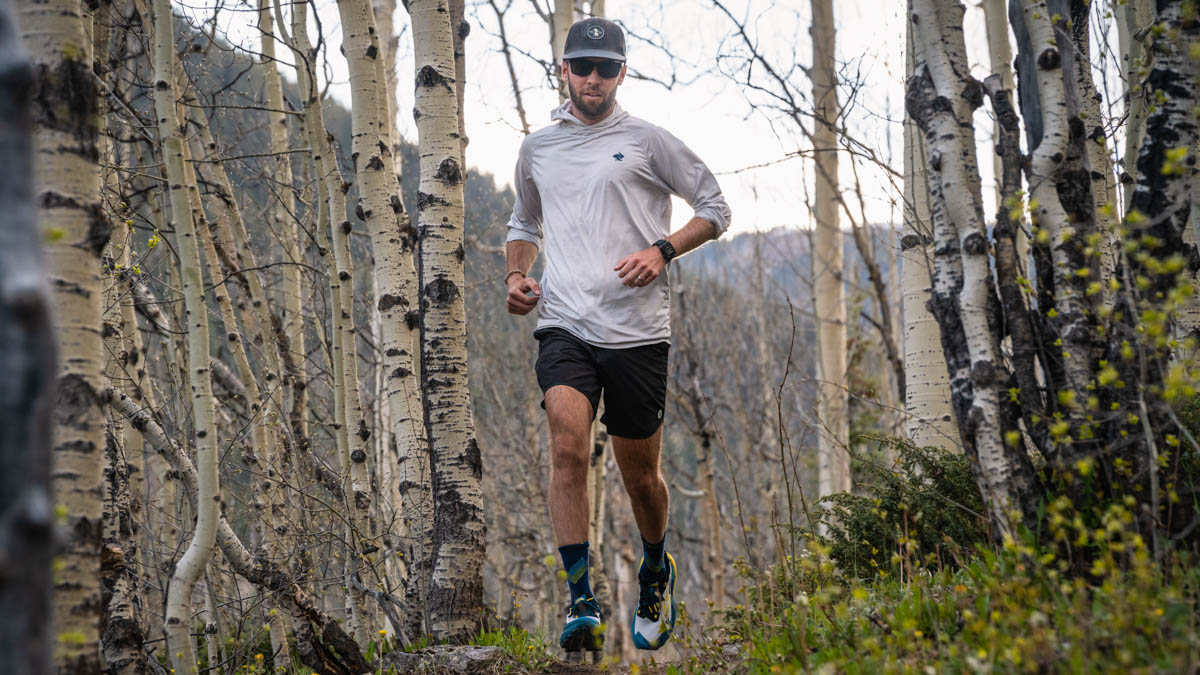
Brooks makes an array of road and trail shoes, including the Catamount 4, which is ideal for nearly any type of trail. Photo: iRunFar/Eszter Horanyi
Initially founded in 1914 to make ballet and bath slippers, Brooks has developed into a modern-day company with a reputation for making durable and reliable running shoes that fit the needs of many types of runners. From the 1940s through the 1960s, Brooks made an array of athletic shoes ranging from roller skates to football, baseball, and softball cleats.
During the jogging craze of the 1970s, the brand pivoted and narrowed its focus to running innovation, capitalizing on the world’s growing fascination with running. The brand continued to improve its shoe technology over the following decades and created a loyal fan base. Today, Brooks shoes are renowned for being exceptional all-around shoes that are ready to perform in any condition.
We tapped into the iRunFar network to create this guide based on our experience testing current and previous shoe models. We chose the Brooks Ghost 17 as our favorite road shoe overall. When it comes to trail running, we turn to the Brooks Cascadia 18, and when we want as much cushion as possible for long miles, the Brooks Caldera 8 is our go-to shoe.
To learn more about how we settled on this list of favorites and how to choose the best Brooks shoe for you, scroll down below our recommendations and check out our frequently asked questions. Finally, learn more about our testing and methodology.
Best Brooks Running Shoes
- Best Overall Road Shoe: Brooks Ghost 17
- Best Overall Trail Shoe: Brooks Cascadia 18
- Best Overall Trail Shoe — Runner-Up: Brooks Catamount 4
- Best Cushioned Trail Shoe: Brooks Caldera 8
- Best Trail Racing Shoe: Brooks Catamount Agil
- Best Road-to-Trail Shoe: Brooks Divide 5
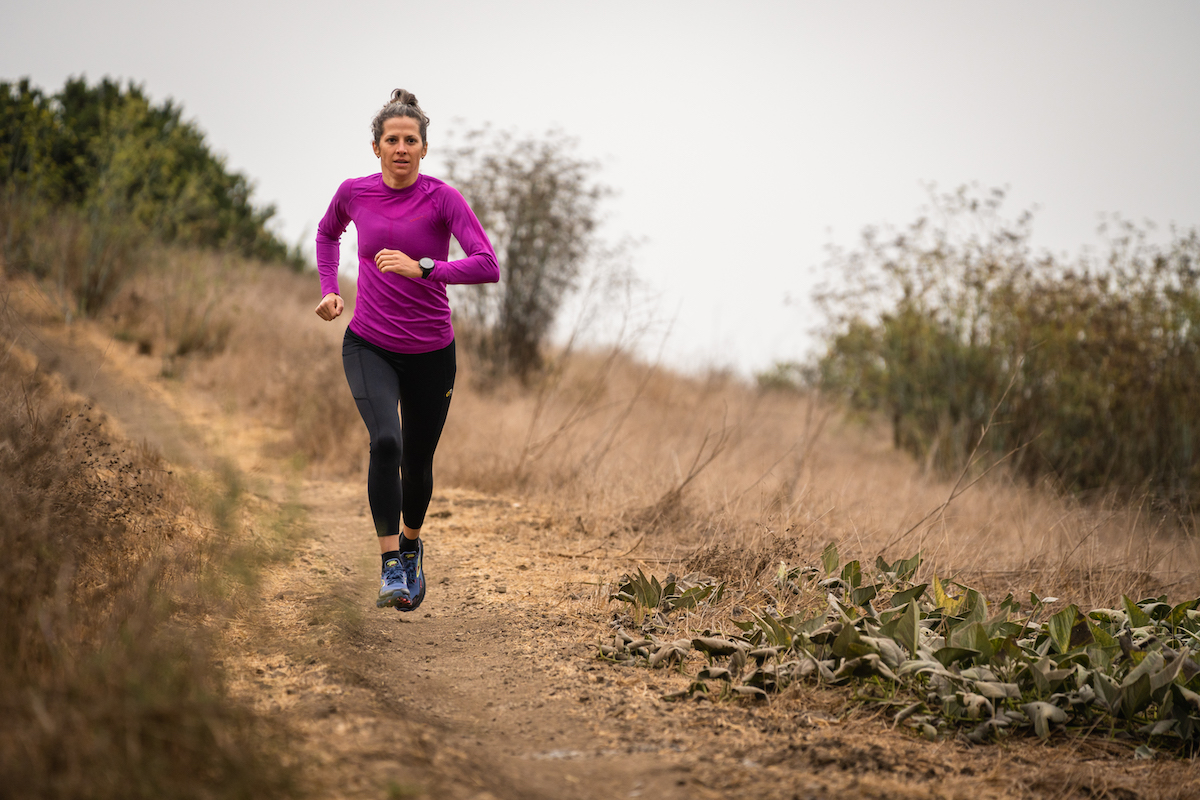
iRunFar’s Alli Miles takes the Brooks Cascadia 18 for a spin on dirt singletrack. Photo: iRunFar/Eszter Horanyi
Best Overall Road Shoe: Brooks Ghost 17 ($150)
- Great for everyday running
- Good balance of weight and cushion
- Stable enough for light trails
Cons:
- No standout features
- A little heavy for speedwork
If you’re looking for a daily trainer or an intermediate marathon shoe, the Brooks Ghost 17 is a solid choice. Coming from a long line of well-loved shoes, this version received a few key updates from the Brooks Ghost 16, which we loved for its reliability and comfort. Brooks tends to make regular, minor adjustments to its shoe designs rather than major overhauls. In the latest Ghost, Brooks has slightly increased its lightweight, nitrogen-infused cushioning in the heel and forefoot, redesigned the upper for improved breathability, and updated the outsole design for a smooth heel-to-toe transition. They also increased the stack height by an average of two millimeters. This shoe features a 10-millimeter drop, which falls within the mid-range for traditional road running shoes.
One of our testers put 112 miles on the Ghost 17 on roads and non-technical trails around Mammoth Lakes, California. He was pleased with how smoothly this shoe performed. He noted that it had a good balance of weight and cushion, and was nimble and stable enough for non-technical trails. Overall, the Brooks Ghost 17 isn’t a standout for fancy features or standout technology, and it isn’t our top pick for speedy interval workouts, but it’s a great day-to-day workhorse of a shoe that will cover the miles comfortably and reliably.
Claimed Weight (U.S. men’s 10): 10.1 ounces (286 grams) | Drop: 10 millimeters | Stack Height: 36.5/26.5 millimeters (heel/toe)
Shop the Men's Brooks Ghost 17Shop the Women's Brooks Ghost 17
Best Overall Trail Shoe: Brooks Cascadia 18 ($140)
- Stable
- Good traction
- Protective toe guard and rock plate
- Moderate cushioning and drop for those who want a neutral shoe
Cons:
- Narrow
- Relatively heavy
The Brooks Cascadia 18 remains a trusted option for trail runners seeking a versatile shoe that can handle a wide range of terrain. Like many Brooks shoes, this one is suitable for a wide range of runners. It has a moderate level of cushion and an 8-millimeter drop.
The newest edition of the shoe retains all the notable upgrades from the previous version, including the addition of the Brooks Trail Adapt System, which integrates the midsole, a rock plate, and the outsole into a single unit to enhance the shoe’s stability and provide a higher level of control. The outsole features the brand’s TrailTack Green Rubber, which features 25% recycled materials. We found the material to be quite sticky, and the 4.5-millimeter lugs, which resemble goat hooves, performed well in various trail conditions, including mud and snow.
The most significant upgrade of this new edition is in the upper, which features a single-layer mesh with overlays in areas prone to wear and tear. The thin overlays, concentrated around the outside of the toebox and front of the shoe, bend easily with the shoe. We found the new upper breathable in hot temperatures, and the shoe drained quickly after we went through streams.
The midsole features DNA Loft v2 foam, and the shoe has a moderate stack height of 20 millimeters. A forked rock plate provides extra protection and stability.
When it comes to a trail shoe that you can trust to cover the miles regardless of the conditions you encounter, this shoe will let you move with confidence. It has earned a place in our best trail running shoes guide. At a very reasonable price, these shoes are a great value.
You can read more in our in-depth Brooks Cascadia 18 review.
Actual Weight (U.S. men’s 9): 10.8 ounces (308 grams) | Drop: 8 millimeters | Stack Height: 20/12 millimeters (heel/toe)
Shop the Men's Brooks Cascadia 18Shop the Women's Brooks Cascadia 18
Best Overall Trail Shoe — Runner-Up: Brooks Catamount 4 ($170)
- Lightweight and fast
- Secure, snug fit
- Surprisingly durable outsole
- Improved responsiveness
Cons:
- Not enough cushion for very long runs
- Expensive
The Brooks Catamount 4 is an excellent all-around trail running shoe. It’s a good mid-range option for anyone seeking a lighter and faster-feeling experience, especially when compared to the Cascadia 18. It’s a fairly techy shoe from Brooks’ carbon-neutral trail running shoe line, so it’s a tad more expensive than the Cascadia 18.
For the upper, Brooks has stayed with the single-layer TPEE mesh introduced in the previous version of the shoe. We found the upper provided a snug, comfortable, and durable fit and feel. It provides a secure lockdown throughout the shoe, and we didn’t feel our feet moving around, even on technical trails. The upgraded laces also helped secure the feet without creating any soreness or hotspots.
Brooks employs its nitrogen-infused DNA Flash v2 technology to create a lightweight, responsive midsole. This new version is stiffer than the previous due to an updated SkyVault Trail Plate, which the brand claims will improve uphill efficiency. We found that the latest version felt significantly snappier than the old one, which we thought felt a little too stiff.
The stack height has increased slightly over the previous version of the shoe, which may lengthen the distance over which this shoe is comfortable. The 6-millimeter drop stays the same: mild and approachable. Likewise, the 3.5-millimeter lugs on the TrailTack Green rubber outsole are good for most surfaces and conditions.
While the Brooks Cascadia 18 reviewed above feels like an everyday trail shoe, this one feels more adept at going fast. One of our testers said that it felt more “premium” than the Cascadia 18. We would choose it for distances up to 50k, but would want a bit more cushion for anything longer.
Overall, you can’t really go wrong with the Catamount 4. It’s a solidly built shoe that excels in many conditions and on many trail types and surfaces.
You can read more about this shoe in our full Brooks Catamount 4 review.
Actual Weight (U.S. men’s 9): 9.1 ounces (258 grams) | Drop: 6 millimeters | Stack Height: 34/28 millimeters (heel/toe)
Shop the Men's Brooks Catamount 4Shop the Women's Brooks Catamount 4
Best Cushioned Trail Shoe: Brooks Caldera 8 ($150)
- Cushioned
- Great traction
- Durable
Cons:
- Excess material can make the shoe feel blocky
- Toebox volume may be too much for narrow feet
The Brooks Caldera 8 is a maximally cushioned shoe that trail runners have turned to for long-distance trail runs and races. It is in our best cushioned trail running shoes guide for its stable ride, breathable upper, ample midsole, and sticky outsole. Recent updates to this shoe have made it slightly lighter and given it a sleeker aesthetic.
The maximal cushioning comes from a midsole made of the brand’s DNA Loft v3 foam. This nitrogen-infused foam is incredibly soft without sacrificing durability. The shoe has a fairly wide base, which adds to its stability and can reduce foot fatigue, but we also found that it made the shoe feel less responsive than other trail shoes.
The shoe’s upper features a breathable TPEE mesh that dries quickly. One of our testers had some issues with the toebox being too roomy for her narrow feet, particularly on runs that went longer than two hours, but ratcheting down the front laces helped address the excess friction. On the flip side, the upper is generally roomy and can accommodate a wide variety of feet. The lacing system provides a good level of lockdown, and the heel felt secure.
Brooks uses their TrailTack Green rubber for the outsole, which features 25% recycled materials. The iRunFar testers are big fans of this outsole, finding that it provides excellent traction on wet and dry surfaces, and the 4-millimeter lugs provide plenty of grip on dry and rocky trails. With well over 100 miles on these shoes, we noticed no significant signs of wear.
You can read about the previous version in our Brooks Caldera 7 review, and watch this space for a full review of this newest version.
Actual Weight (U.S. men’s 9): 10.6 ounces (299 grams) | Drop: 6 millimeters | Stack Height: 35/29 millimeters (heel/toe)
Shop the Men's Brooks Caldera 8Shop the Women's Brooks Caldera 8

The Brooks Caldera 8 offers maximal cushioning and is a great option for long runs and ultrarunning. Photo: iRunFar/Bryon Powell
Best Trail Racing Shoe: Brooks Catamount Agil ($180)
- Fast, efficient, and good energy return
- Stable
- Secure and breathable upper
- Excellent value
Cons:
- Lacks the versatility of an everyday running shoe
The Brooks Catamount Agil is the brand’s premier off-road racing shoe. Our tester summed up his experience with the shoe in one word: “Fast!” That fast feeling comes from a few features. First, the shoe is incredibly light, weighing only 7.9 ounces for a U.S. men’s 9. Next, Brooks employs some of its newest top-end technology, including the SpeedVault Trail Plate, improving energy return alongside the DNA Flash v2 midsole.
Our tester noted that the new midsole enhanced the shoe’s responsiveness, and the trail plate improved its propulsive capabilities. We also appreciate the shoe’s lower stack height and drop. The stack height is 27 millimeters at the heel, dropping to 21 millimeters at the toe for a 6-millimeter drop. This helps the shoe feel more stable, less wobbly, and better at fast downhill running on technical trails.
Our tester also praised the shoe’s lightweight and breathable upper, which includes about 50% recycled materials. The outsole, made from Brooks TrailTack Green rubber material, is also more environmentally friendly than the previous outsole. The 4.5-millimeter lugs provide plenty of grip.
Finally, at $180, this higher-end shoe is an excellent value.
Actual Weight (U.S. men’s 9): 7.9 ounces (226 grams) | Drop: 6 millimeters | Stack Height: 27/21 millimeters (heel/toe)
Shop the Brooks Catamount AgilBest Road-to-Trail Shoe: Brooks Divide 5 ($110)
- Lightweight
- Versatile
- Great value
Cons:
- Not enough cushion for long runs
- Not enough traction for technical trails
The Brooks Divide 5 is an exceptional road-to-trail shoe that is equally at home on gravel paths, smooth singletrack, and pavement. Brooks upgraded the cushioning on this model and improved the upper to create a lightweight shoe ideal for shorter runs that connect roads with trails. It’s more than an ounce lighter than the Cascadia 18 reviewed above and feels nimble on the feet.
The upper is a breathable mesh with a smooth layer underneath. The TPU overlays add some extra stability and durability, and we found that the lockdown was solid throughout the midfoot and heel. We didn’t feel like our heel or foot moved at all, even on off-camber trails. Like most shoes from the brand, the toebox is relatively roomy, and the upper fits more like a road shoe than a dedicated trail shoe.
Brooks has added four millimeters of DNA Loft v2 midsole material to the stack height, increasing the shoe’s overall cushion. The EVA foam feels softer and more responsive than previous shoe versions, and we appreciated the rock plate’s protection. We found that the shoe stood up to about 15 miles before we wished for a bit more cushion underfoot.
The TrailTack Green outsole is sticky, made from 25% recycled material, and features 3-millimeter lugs that provide sufficient traction on trails, as long as they don’t become too steep or loose. We found the outsole excelled on crushed gravel and similar surfaces.
This shoe is also an excellent option for running in the winter when you want to use a traction device, since the lugs don’t get in the way. A Gore-Tex version, the Brooks Divide 5 GTX, is available for those seeking a shoe that offers extra protection in cold and wet conditions.
You can read more about this shoe in our in-depth Brooks Divide 5 review.
Actual Weight (U.S. men’s 9): 9.9 ounces (282 grams) | Drop: 8 millimeters | Stack Height: 24/16 millimeters (heel/toe)
Shop the Men's Brooks Divide 5Shop the Women's Brooks Divide 5
Comparing the Best Brooks Running Shoes
| SHOE | PRICE | WEIGHT | DROP | STACK HEIGHT |
| Brooks Ghost 17 | $150 | 10.1 ounces | 10 millimeters | 36.5/26.5 millimeters |
| Brooks Cascadia 18 | $140 | 10.8 ounces | 8 millimeters | 20/12 millimeters |
| Brooks Catamount 4 | $170 | 9.1 ounces | 6 millimeters | 34/28 millimeters |
| Brooks Caldera 8 | $150 | 10.6 ounces | 6 millimeters | 35/29 millimeters |
| Brooks Catamount Agil | $180 | 7.9 ounces | 6 millimeters | 27/21 millimeters |
| Brooks Divide 5 | $110 | 9.9 ounces | 8 millimeters | 24/16 millimeters |
Glossary for Brooks Running Shoes
Running shoe terminology can be confusing and full of jargon. Below, we break down commonly used terms for all running shoes, as well as terms specific to Brooks running shoes.
- Stack Height: Stack height is the height between the bottom of the shoe and the bottom of your foot. Running shoe brands typically measure stack height in millimeters, typically in the range of 10 to 40 millimeters. These days, most running shoes have stack heights in the 20- to 30-millimeter range.
- Drop: Drop is the difference between the stack height under the heel and the stack height under the forefoot of a shoe. In running shoes, drop ranges from none in zero-drop shoes up to 12 millimeters. Most trail running shoes have a drop in the 4- to 10-millimeter range. Road running shoes often have a little more drop.
- Lugs: Lugs are the protrusions of material attached to the outsole of a shoe that provide traction. Lugs are generally found in trail shoes and can range from a few millimeters deep to 12 millimeters for mud-specific shoes. Road shoes don’t typically have lugs. If they do, they’re quite small.
- Midsole: The midsole is the soft foam material between the outsole and the sock liner. Different types of foam can provide various levels of support, cushion, and energy return. Generally, a thicker midsole results in a more cushioned shoe. Most running shoe brands create their own proprietary midsole foam.
- Outsole: The outsole is the bottom of the shoe that makes contact with the ground. It is typically a type of rubber or a similarly sticky material.
- Rock Plate: A rock plate is a plastic or similarly rigid material placed above the shoe’s outsole to protect the foot from rocks and other debris. Plates are found in many trail shoes and can range in length from covering just the forefoot to stretching the whole length of the shoe. Combined with midsole foam, plates can also serve to add stiffness or responsiveness to a shoe.
- Toebox: The toebox is the front of the shoe where the toes sit. Performance shoes are often more fitted in the toebox, while others might be a bit wider to allow the toes to splay.
- Rocker: Rocker is the rounded shape of the midsole and outsole that helps move the runner more efficiently through their stride. It’s similar to the rocker profile found in skis and snowboards that helps them stay afloat in powder snow.
- DNA Loft: This is Brooks’ base-level midsole material made of EVA foam and rubber. A newer version of this foam, DNA Loft v3, is nitrogen-infused and is the brand’s softest, lightest, and most responsive version. Brooks considers it its softest midsole foam. Brooks still uses both foams in different shoes.
- DNA Amp: Brooks’ highest-energy-return midsole foam features polyurethane (PU) foam inside a thermoplastic polyurethane (TPU) layer. It is a good option for a workout or speed shoe.
- BioMoGo DNA: The BioMoGo DNA midsole foam balances the difference between DNA Loft and DNA Amp. It hits a middle ground of softness between the two. It provides more energy return than the DNA Loft but not quite at the level of the DNA Amp.
- DNA Flash: This is Brooks’ racing shoe foam. Not surprisingly, it’s the lightest cushioning Brooks offers. It’s responsive but not quite as springy as the DNA Amp.

The iRunFar team has been testing Brooks running shoes for decades. Photo: iRunFar/Alli Miles
How to Choose Brooks Running Shoes
Road versus Trail Shoes
For this guide, we looked at the brand’s top road and trail shoes. The primary difference between road and trail shoes lies in their outsoles. Road shoe outsoles are generally smooth, with just enough traction to prevent slipping on roads, while trail running shoes have lugs that provide purchase on rugged off-road terrain. Additionally, many trail shoes, such as the Brooks Cascadia 18, have a rock plate between the outsole and the sock liner to protect the feet from rocks and roots.
Trail shoes will often also have a more durable upper to keep them from getting shredded while running through brush and rock. Road shoes are also typically lighter, as they do not include extra materials such as a rock plate, toe cap, or mudguard.
The type of shoe that works best for you should reflect where you spend most of your time running. If you’re typically on the pavement, go for a road shoe like the Brooks Ghost 17. The Brooks Catamount 4 is a good option if you’re looking for a higher-end trail shoe for shorter distances. If you run on both roads and trails in the same outing, consider a hybrid shoe like the Brooks Divide 5, which can comfortably handle both.
Drop Height
Drop height is a matter of personal preference. Drop usually ranges from zero to 12 millimeters. Generally, a low-drop shoe has a drop of less than 4 millimeters. Mid-drop shoes have a 5- to 8-millimeter difference between their heel and toe, and high-drop shoes have up to 12 millimeters.
A low-drop shoe encourages a different type of running gait than a high-drop shoe and suits a different type of runner. High-drop shoes tend to work well for runners who heel-strike or have issues with their Achilles or calf muscles. None of the shoes in this guide have a low drop. The Brooks Catamount 4 and Brooks Caldera 7 have the lowest drops in the guide at 6 millimeters. The Brooks Ghost 17, a road shoe, has a 10-millimeter drop.
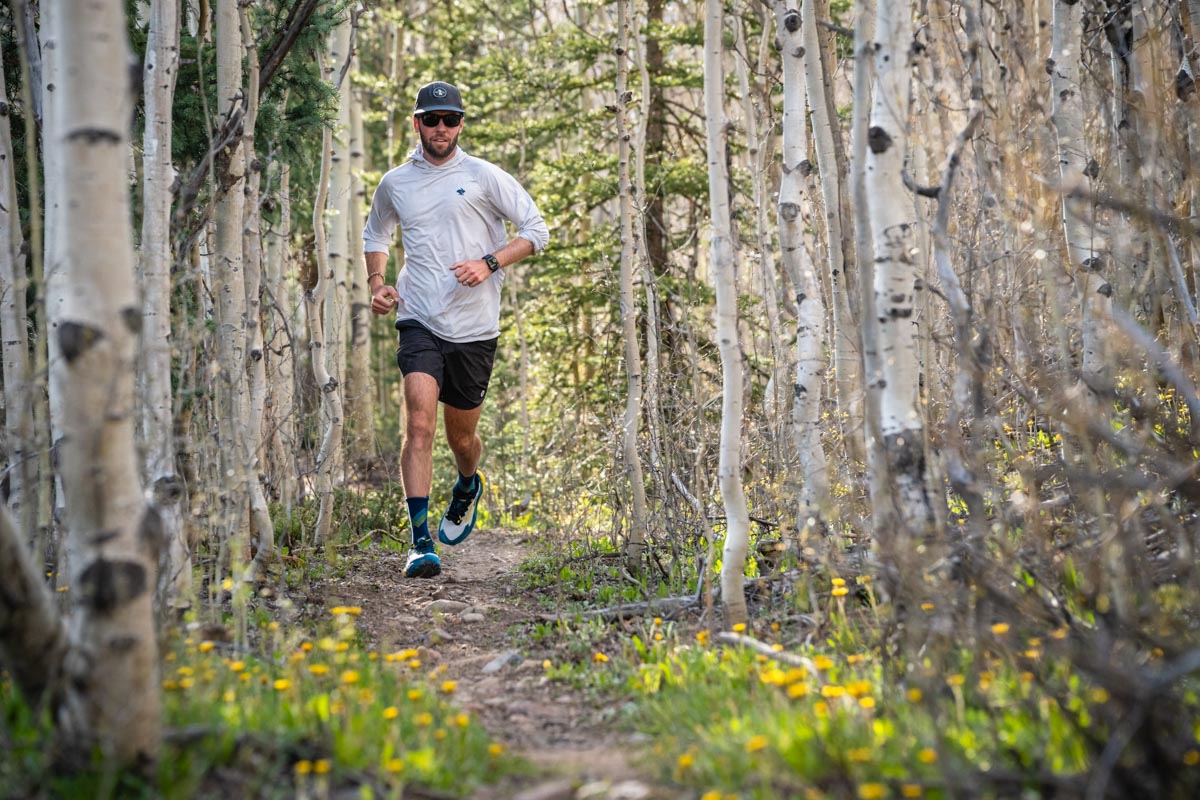
The Brooks Catamount 4 is a lightweight trail shoe suitable for distances of up to 50k. Photo: iRunFar/Eszter Horanyi
Cushioning
The maximalist movement has been gaining momentum for the past decade or so, and most modern running shoes now come with a decent amount of cushioning. Generally, shoes with a higher stack height are more cushioned; however, the quality of the foam used in the midsole also plays a role in a shoe’s comfort. Foam can feel springy or mushy, so using stack height as the sole gauge of cushion isn’t always accurate.
A shoe like the Brooks Divide 5 has relatively low cushioning and is ideal for shorter runs, whereas the Brooks Ghost 17 offers sufficient cushioning for long miles on pavement.
Materials
Brooks uses a variety of proprietary materials in its shoes. The uppers of its higher-end shoes generally feature engineered mesh, while entry-level and base models feature knit mesh. For its midsoles, Brooks utilizes several different types of foam, including DNA Loft, DNA Amp v2, and DNA Loft v3, in the Brooks Caldera 8. In its highest-end shoes, such as the Brooks Catamount Agil, the brand utilizes its DNA Flash v2 midsole foam. Each foam has distinct characteristics, creating shoes that excel in specific conditions.
Brooks also uses two different outsole rubbers. Some shoes feature the TrailTack rubber, while the TrailTack Green rubber, made of 25% recycled materials, is found on the Brooks Cascadia 18 and the Brooks Caldera 8.

Brooks offers waterproof “GTX” versions of its popular Ghost, Adrenaline, Cascadia, and Divide models. Photo: iRunFar/Lexi Miller
Price and Durability
Brooks offers a wide variety of shoes at different prices — there’s something for everyone. If you’re looking for a race shoe, the Brooks Catamount Agil is a solid off-road option, and it’s also the most expensive at $180. Mid-range shoes like the Brooks Cascadia 18 or the Brooks Ghost 17 cost $140. The Brooks Divide 5, at $110, is a great shoe at an affordable price.
While the initial thought is that more expensive shoes will last longer, that’s not always the case. High-end race shoes often sacrifice durability for the sake of weight and performance, and should only be used for fast training sessions or on race day — unless you’re willing to spend a lot of money on shoes. Similarly, some lower-end shoes may not withstand the same mileage as a more mid-range shoe. Generally, Brooks shoes have a reputation for offering great value, meaning they’re reliable, durable, and well-built without breaking the bank.
Why You Should Trust Us
Brooks is a go-to brand for several iRunFar team members, and we have been testing the company’s shoes for many years. Brooks trail shoes have been part of the iRunFar team’s rotation since the dawn of this site, and we’ve collectively put thousands of miles on them over the years.
To select shoes for this guide, we drew on our experience with the brand and researched new models we hadn’t previously tested. We took shoes on a wide variety of terrain to explore their limits. We evaluated these shoes on comfort, durability, breathability, cushion, and responsiveness.
To create this guide, we ran the shoes on smooth trails, roads, bike paths, and technical and rugged routes. We took them out in various weather conditions and on everything from easy recovery runs to long runs, and we also did speedwork and races in them.
Frequently Asked Questions About Brooks Shoes
What is the best Brooks shoe for a marathon?
The Brooks Catamount Agil is the brand’s best option for an off-road marathon. While this shoe offers moderate cushioning, it is lightweight and features excellent energy return. We found it to be highly propulsive. Brooks says it’s good for racing anything less than 50k, and we agree. We also found that the Brooks Caldera 8 provided enough cushion for racing distances of 50k or more.
If you’re preparing for a road marathon, the Brooks Ghost 17 is a well-cushioned option that will protect your feet and joints as you build your distances. It’s not our first choice overall for a marathon racing shoe, but it will definitely do the trick and is an excellent choice for first-time marathoners.
What is the best overall Brooks running shoe?
The Brooks Ghost 17 remains a solid choice for road shoes. It comes from a long lineage of shoes and offers reliable and consistent service. Not a flashy shoe by any stretch, you can trust it to go the distance, mile after mile. This workhorse shoe features excellent durability and cushioning.
For off-road running, we like the Brooks Cascadia 18. It’s a versatile shoe that can handle various surfaces and trail types.
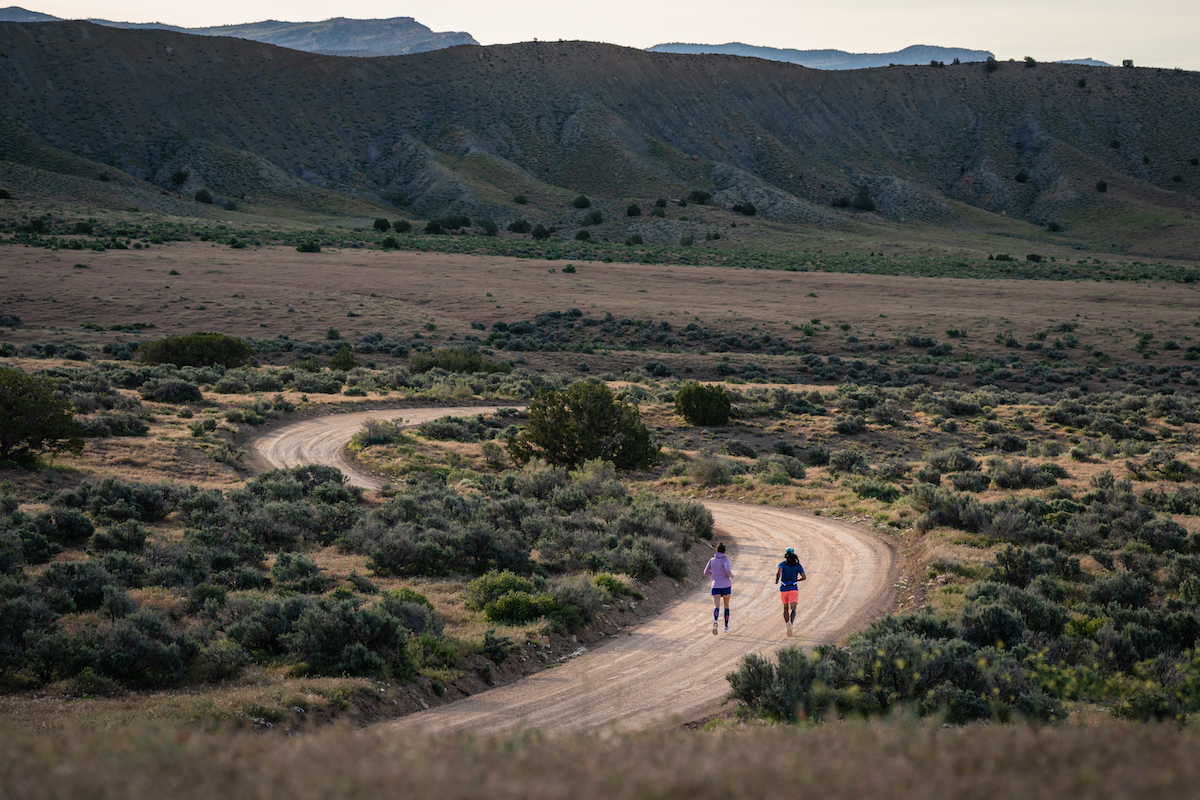
Regardless of the type of surface you run on, there’s a Brooks shoe that will excel. Photo: iRunFar/Eszter Horanyi
Is Brooks a good running shoe brand?
Brooks has been around for a long time and continues to make consistent, if not flashy, shoes. Their fit tends to be very middle-of-the-road, and as a result, they are accessible to a wide range of runners. The 6-millimeter drop of the Brooks Catamount 4, Brooks Caldera 8, and Brooks Catamount Agil will work for many different types of runners.
The brand continues to innovate with its upper, midsole, and outsole materials, making small yet incremental improvements to its shoe lines that will keep loyal fans coming back for more. The brand is well-known for making a range of great everyday running shoes.
Call for Comments
- Have you had a chance to run in any of the Brooks shoes on this list?
- Do you have a Brooks shoe you love that we should try?
